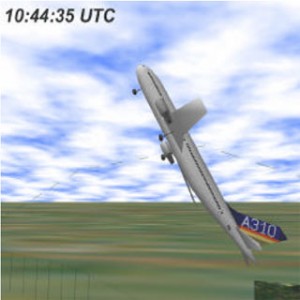
TAROM A310 (YR-LCA) flight ROT381
The Romanian Tarom Airbus A 310 YR-LCA, coming from Bucharest as scheduled flight ROT 381, estimated its arrival time at Paris Orly at 10 h 40. The Orly ATIS indicated that runway 26 was in service and visibility announced was ten kilometers with scattered cloud at 2,400 feet.
The aircraft left cruise level 350 at 10 h 30 at the request of regional control. At about 40 NM from the runway, at 10 h 36, it descended through flight level 150. The ATC asked the pilot to accelerate descent so as to reach level 60 in two minutes maximum.
At 10 h 37 m 13 s, the crew contacted approach control. The controller asked them to set a heading of 330° with a base leg for runway 26. The aircraft flew over the Melun VOR at 10 h 38 m 39 s, descended through to 6,600 feet with a ground speed of 400 kt. It was then authorized at 10 h 38 m 44 s to descend to an altitude of 3,000 feet.
At 10 h 41 m 01 s, the approach controller asked the flight crew to change to heading 310 for interception of ILS 26. Conversations in the cockpit show that the runway was in sight, as were certain Parisian monuments. The Captain was at the controls. He decided to perform an automatic approach and landing. Approach control was not informed of this.
The flight crew started to put the aircraft into the approach configuration, with slats and flaps at 15/0 at 10 h 42 m 05 s, then at 15/15 at 10 h 42 m 53 s. The landing gear was extended at 10 h 42 m 57 s.
Approaching the OYE beacon at indicated speed 250 kt and heading 325, before lining up with the runway, the Captain noted that the aircraft was not capturing the ILS glide slope automatically. He disconnected the AP and continued the approach on manual control, keeping the Autothrottle in operation.
The Captain did not delegate any task or action to the co-pilot who, in turn, proposed no emergency action.
As the aircraft descended through 1,700 feet, at 10 h 43 m 22 s, with a speed of about 195 knots, the Captain asked for flap extension to 20°. The VFE, the speed limit authorized for this new configuration, is 195 knots. When the flap control was set to 20°, the thrust levers advanced and engine thrust increased.
The flight crew countered the nose-up effect resulting from the increase in thrust by using the pitch controls, with the auto-throttle (ATHR) remaining in automatic mode.
The throttle levers were then quickly brought back to the idle position. At the same time, the trimmable horizontal stabilizer started to move in a nose-up direction.
The nose up effect that resulted was countered by the flight crew through gradual nose-down action on the elevators. When the trimmable horizontal stabilizer reached its maximum nose-up value and the elevators also reached their maximum nose down value, the throttle levers, according to the FDR readout, moved rapidly to their stops.

TAROM A310 (YR-LCA) flight ROT381
In a few seconds, the flight path started to rise and the pitch attitude went to 60°.
Witnesses saw the aircraft climb. It banked sharply to the left and the right and stalled before adopting a strongly negative pitch attitude (-33 degrees) towards the ground.
The maximum altitude reached was 4,100 feet, while a minimum indicated speed of 35 knots was recorded. The stall and ground proximity warnings sounded during the descent. The flight crew managed to regain control of the aircraft, with the lowest point being around a height of 800 feet, that is 240 meters from the ground.
The flight crew then performed a visual circuit, followed from the tower by the controller. The second approach was made with a configuration with slats and flaps at 20/20. Landing took place at 10 h 52 m 25 s. The aircraft went directly to its parking area.
3.2 Probable Causes
The direct causes of the unusual attitudes and the stall to which the aircraft was subjected were a movement of the THS towards the full pitch-up position and a rapid increase in thrust, both of which maneuvers were the due to the Captain, following an AFS mode reversion which was not understood.
The pitch-up force caused a sudden change in attitude that the flight crew was unable to contain with the elevators.
The following elements contributed to the incident:
- Too rapid an approach, due to a late start in the descent, followed by a reduction of the standard procedure.
- Inadequate crew resource management.
- Premature selection of the go around altitude and precipitous setting of the configuration with slats and flaps at 20-20, which led to activation of the speed protection.
- Difficulty in understanding the action of the auto-throttle increasing thrust in its overspeed protection function.
Download Report

0 Comments